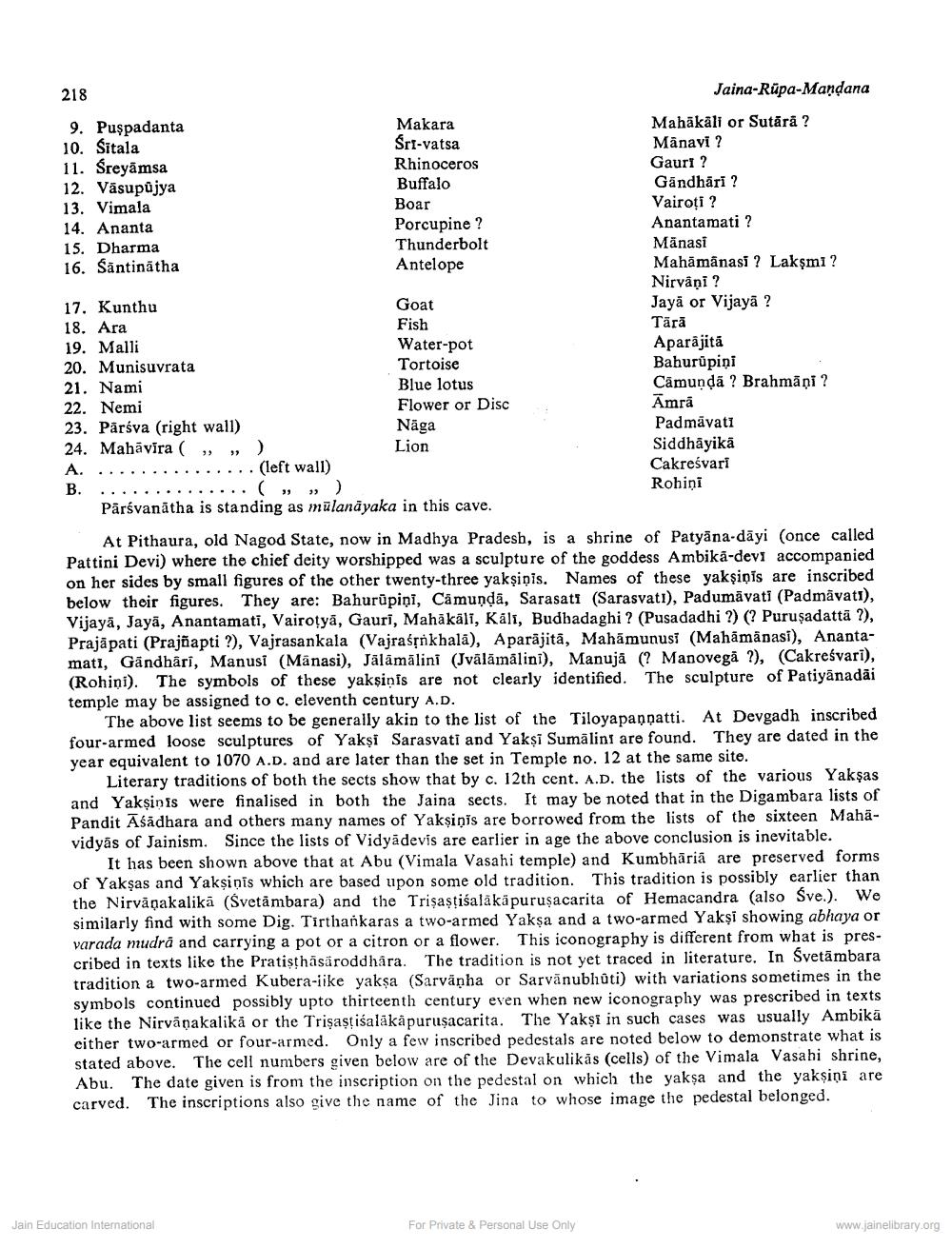________________
218
9. Puspadanta 10. Sitala 11. Sreyāmsa 12. Vasupujya 13. Vimala 14. Ananta 15. Dharma 16. Santinātha
Makara Sri-vatsa Rhinoceros Buffalo Boar Porcupine ? Thunderbolt Antelope
Jaina-Rupa-Mandana Mahākäli or Sutārå ? Mānavi ? Gauri? Gāndhāri? Vairoți ? Anantamati? Mānasi Mahāmānasi? Lakşmi ? Nirvani ? Jaya or Vijayā ? Tārā Aparajitā Bahurupini Cāmunda ? Brahmani ? Amra Padmavati Siddhāyika Cakreśvari Rohiņi
17. Kunthu
Goat 18. Ara
Fish 19. Malli
Water-pot 20. Munisuvrata
Tortoise 21. Nami
Blue lotus 22. Nemi
Flower or Disc 23. Pārsva (right wall)
Näga 24. Mahāvīra ( , )
Lion A. ............... (left wall) B. .............. (
) Pārsvanātha is standing as mulanāyaka in this cave.
At Pithaura, old Nagod State, now in Madhya Pradesh, is a shrine of Patyāna-dāyi (once called Pattini Devi) where the chief deity worshipped was a sculpture of the goddess Ambika-devi accompanied on her sides by small figures of the other twenty-three yakşinis. Names of these yakşiņis are inscribed below their figures. They are: Bahurūpiņi, Cämunda, Sarasati (Sarasvati), Padumävati (Padmavati), Vijaya, Jaya, Anantamati, Vairoțya, Gauri, Mahākäli, Kāli, Budhadaghi ? (Pusadadhi ?) (? Puruşadattā ?), Prajāpati (Prajwapti?), Vajrasankala (Vajraśříkhala), Aparajita, Mahamunusi (Mahämänasi), Anantamati, Gāndhari, Manusi (Manasi), Jālāmālini (Jvālāmālini), Manujā (? Manovega ?), (Cakreśvari), (Rohini). The symbols of these yaksinis are not clearly identified. The sculpture of Patiyānadai temple may be assigned to c. eleventh century A.D.
The above list seems to be generally akin to the list of the Tiloyapannatti. At Devgadh inscribed four-armed loose sculptures of Yakşi Sarasvati and Yaksi Sumālint are found. They are dated in the year equivalent to 1070 A.D. and are later than the set in Temple no. 12 at the same site.
Literary traditions of both the sects show that by c. 12th cent. A.D. the lists of the various Yaksas and Yaksinis were finalised in both the Jaina sects. It may be noted that in the Digambara lists of Pandit Asadhara and others many names of Yaksinis are borrowed from the lists of the sixteen Mahavidyās of Jainism. Since the lists of Vidyadevis are earlier in age the above conclusion is inevitable.
It has been shown above that at Abu (Vimala Vasahi temple) and Kumbhāriã are preserved forms of Yakşas and Yaksinis which are based upon some old tradition. This tradition is possibly earlier than the Nirvånakalika (Svetambara) and the Trişaştiśalakäpuruşacarita of Hemacandra (also Sve.). We similarly find with some Dig. Tirthankaras a two-armed Yaksa and a two-armed Yakşi showing abhaya or varada mudra and carrying a pot or a citron or a flower. This iconography is different from what is prescribed in texts like the Pratisthāsäroddhara. The tradition is not yet traced in literature. In Svetämbara tradition a two-armed Kubera-iike yakşa (Sarvāṇha or Sarvānubhūti) with variations sometimes in the symbols continued possibly upto thirteenth century even when new iconography was prescribed in texts like the Nirvāņakalika or the Trişastiśalākāpuruşacarita. The Yakşi in such cases was usually Ambikā either two-armed or four-armed. Only a few inscribed pedestals are noted below to demonstrate what is stated above. The cell numbers given below are of the Devakulikās (cells) of the Vimala Vasahi shrine, Abu. The date given is from the inscription on the pedestal on which the yaksa and the yaksini are carved. The inscriptions also give the name of the Jina to whose image the pedestal belonged.
Jain Education International
For Private & Personal Use Only
www.jainelibrary.org




